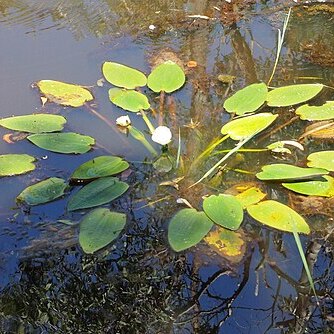Robust, tufted, scapose perennial. Leaves all basal; juvenile submersed. linear, transparent, short-petiolate; older leaves ovate or oblong, obtuse, floating, with 7 strong nerves connected by fine cross-veinlets; petioles septate, to 40 cm long. Flowers bisexual, large, white solitary and sessile within a 2-lobed, tubular, 6-ribbed spathe c. 6 cm long, terminal on a stout scape. Perianth-tube > spathe. Sepals 3, green, 1.5-3 cm long; petals 3, to 4 cm long, fragile, white with orange base. Stamens 6-12, orange. Stigmas 6-8, bifid. Capsule narrowly ovoid, 2-5 cm long, beaked, enclosed within spathe. Seeds many.
A tufted plant with floating leaves and flowers. It is rooted in the mud. It can re-grow each year or continue to grow from year to year. The leaves arise from the base of the plant. They are on long stalks which have wings near the base. These can be up to 1 m long allowing the leaves to float. The leaves are oval. Young leaves are thin and strap-like. The flowers have 3 yellow petals. These usually have a purple blotch near the base. The flowers are on a stout stem which supports them above the water. After being fertilised, the stems turn downwards and the seeds develop.

